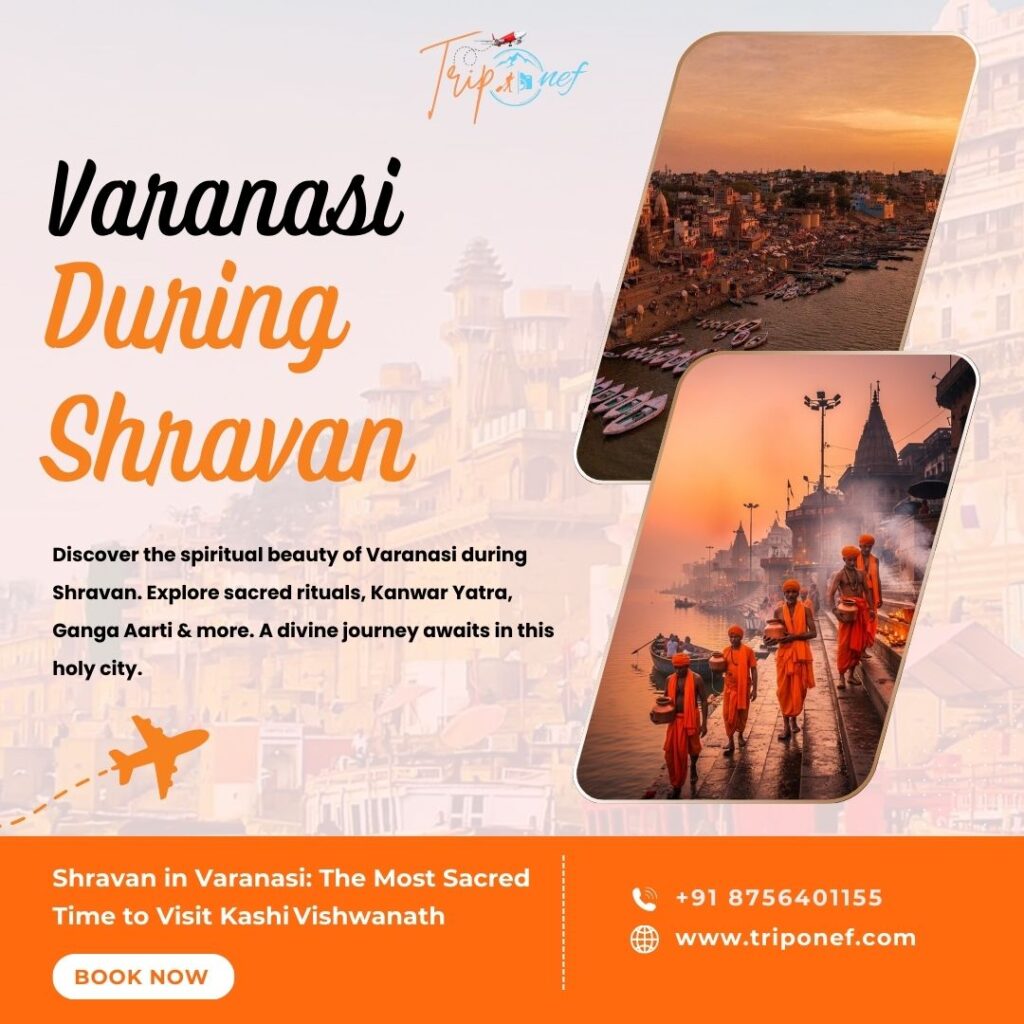
🪔 Introduction: The Spiritual Call of Varanasi During Shravan
When the monsoon clouds hover above the holy Ganges, and the sound of “Har Har Mahadev” echoes through narrow stone-paved lanes, you know Shravan has arrived in Varanasi. This isn’t just a season—it’s a spiritual revolution that overtakes the city. Varanasi during Shravan is not merely a destination; it’s an emotion—one that fills the air with faith, rituals, and a strange sense of peace even amidst chaos.
Shravan, also known as Sawan, is the holiest month in the Hindu calendar, especially for devotees of Lord Shiva. And what better place to witness the magic of this sacred month than Kashi—the city where Lord Shiva himself is believed to reside?
What Makes Shravan Month So Important?
Shravan, the fifth month in the Hindu lunar calendar, usually falls between July and August. It is believed that during this month, the divine energies on Earth are at their peak, making it the ideal time for prayers, fasts, pilgrimages, and rituals. Monday fasts (Shravan Somvar), Kanwar Yatra, and Rudrabhishek are some of the many ways in which devotees seek the blessings of Mahadev.
Now imagine performing these rituals in Varanasi, the spiritual capital of India, where every corner breathes divinity. That’s what makes visiting Varanasi during Shravan a once-in-a-lifetime experience.
Ganga Ghats: Where Devotion Flows with the River
At the break of dawn, the ghats of Varanasi begin to buzz with activity. Pilgrims arrive barefoot, many after walking for days, to take a holy dip in the Ganga before heading to temples. The river, swollen and alive due to the monsoon, reflects not just the sky—but the spiritual energy of thousands.
Dashashwamedh Ghat sees long lines for a quick bath.
Assi Ghat becomes a hub for sunrise prayers and meditation.
Manikarnika Ghat, usually reserved for cremations, too becomes a site of introspection and deeper connection.
During Shravan, it feels as though the river itself joins the celebration.
Kashi Vishwanath Temple: The Divine Magnet
No journey to Varanasi during Shravan is complete without a visit to the Kashi Vishwanath Temple, one of the 12 Jyotirlingas. This sacred temple attracts lakhs of devotees during this month, all hoping to glimpse the divine lingam of Shiva.
The air around the temple is thick with:
Mantras chanted in unison.
The fragrance of sandalwood and flowers.
Bells ringing with every offering.
Many spend hours in line, chanting “Om Namah Shivaya” while waiting for darshan. Despite the crowd, there’s an inexplicable serenity that envelopes you as you walk through the gates.
Kanwar Yatra: The March of Faith
One of the most striking sights in Varanasi during Shravan is the arrival of Kanwariyas—devotees clad in saffron, carrying sacred Ganga water in pots hanging from decorated bamboo sticks on their shoulders. These pilgrims walk barefoot, often for hundreds of kilometers, to pour the holy water on Shivlingas in their local temples.
The streets of Varanasi roar with their chants:
“Bol Bam! Har Har Mahadev!”
These chants are not just loud—they’re emotionally intense. You can feel their faith in the way they walk, sing, and pray. Entire roads are blocked off to allow the Kanwar processions to pass, and local residents come out to offer food, water, and medical help—a true community celebration of faith.
Monsoon in Varanasi: A Visual and Emotional Delight
Shravan coincides with the Indian monsoon, turning Varanasi into a lush, mystical place. Rain-soaked ghats, mist-covered temples, and the earthy smell of wet stone create a dreamlike atmosphere.
Here’s what adds to the monsoon charm of Varanasi during Shravan:
Rain-kissed marigold garlands hung outside temples.
Sadhus sitting under umbrellas, meditating.
The sound of drums, bells, and thunder blending into one symphony.
Floating diyas drifting down the swollen Ganges in the evening.
Every element becomes part of the divine canvas that is Varanasi.
Shravan Special Foods in Varanasi
Shravan is a month of sattvik food and fasting, but that doesn’t mean the culinary experience is dull. In fact, the fasting menu in Banaras is full of delicious surprises!
Here’s what you must try:
Sabudana Khichdi with crushed peanuts and ghee
Kuttu Puri with Aloo ki sabzi
Banarasi Thandai (without bhang)
Fruit chaat with rock salt and lemon
Hot jalebis and malpuas in the evening
Many locals also distribute free prasad and sweet pongal during Shravan Mondays. The food becomes a sacred offering—nourishing both body and soul.
Devotion in Every Lane and Corner
Walk down any gali in Varanasi during Shravan, and you’ll see devotion stitched into the city’s fabric:
Young boys reciting the Shiva Tandav Stotra.
Women lighting diyas and tying red threads around peepal trees.
Temple priests chanting slokas under dripping temple roofs.
Shopkeepers offering free incense sticks or tulsi leaves to passersby.
Even the graffiti on the walls—artistic depictions of Shiva and Parvati—seem more alive during this time.
A Photographer’s Dream
Shravan is perhaps the most visually compelling time to visit Varanasi. Whether you’re a travel blogger, a filmmaker, or just someone who loves Instagram—this city offers once-in-a-lifetime shots:
Aerial views of ghats filled with saffron crowds
Close-ups of wrinkled, faith-filled faces of old sadhus
Water-soaked temples glowing under flickering diyas
The reflection of Shiva trishuls in puddles
Ganga Aarti in the rain, with umbrellas, flames, and thunder
Emotional & Spiritual Benefits
Visiting Varanasi during Shravan doesn’t just offer outer adventure—it’s an inner journey:
Spiritual cleansing through rituals and Ganga snan
Mental peace through chants and temple bells
Emotional healing by being part of something larger than yourself
Detachment from routine and reconnection with your spiritual roots
It’s hard to describe in words—but thousands of travelers say they leave transformed.
Travel Tips for Shravan Pilgrims
If you’re planning to visit Varanasi during this sacred month, here are some must-follow tips:
Book Early: Shravan is peak season for religious tourism. Hotels fill up fast.
Respect Devotees: Give way to Kanwariyas, avoid interfering in rituals.
Stay Hydrated: It’s humid and crowded—carry your own water.
Pack Smart: Include umbrellas, raincoats, waterproof shoes, and modest clothes.
Avoid Plastic: Use eco-friendly containers, especially near the river.
Stay Near the Ghats: For easy access to rituals, aarti, and temples.
Final Thoughts: The Divine Pulse of Varanasi in Sawan
Some places are meant to be seen. Others are meant to be felt. Varanasi during Shravan is one such place. It is chaotic yet calming, crowded yet peaceful, overwhelming yet healing.
Whether you’re religious or simply curious, visiting Kashi in Sawan will awaken a part of you that’s been asleep. You’ll return not just with photos, but with stories, chants, and emotions that stay long after the journey ends.
👉 Ready to feel the divine rhythm of Varanasi during Shravan? Book your spiritual getaway now with Triponef and let your soul walk where gods once did.

